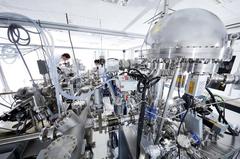URL: https://www.desy.de/news/news_search/index_eng.html
Breadcrumb Navigation
DESY News: Nano material of a new class
News
News from the DESY research centre
Nano material of a new class
Classical materials such as ceramics, metals and polymers have their typical mechanical properties. They are hard, soft, strong, flexible or stiff. Hamburg research scientists have now synthesized a material that unites several different properties, and could thereby open the way to new applications in medical engineering and manufacturing. The scientists from the Hamburg University of Technology (TUHH), the University of Hamburg, the Helmholtz Centre Geesthacht and DESY have presented their novel nanocomposite in the journal “Nature Materials”. This new class of material could for example be suitable for filling dental cavities, or manufacturing watch cases. The materials used in applications like these need to be both hard and damage-tolerant.

Ultra-high vacuum chamber at the DESY-NanoLab, in which the spectroscopic analysis was carried out to characterise the nature of the bond formed by the oleic acid molecules. Credit: DESY, Heiner Müller-Elsner
“The self-organisation of these nanoparticles leads to an extended, closely packed supercrystal reminiscent of atomic crystal lattices,” explains one of the authors, Axel Dreyer from the TUHH. The crucial discovery is that by subsequently exposing the material to moderate heat levels, the resulting nanocomposite displays a much stronger cohesion and its mechanical properties are unlike those of any other.

High resolution transmission electron microscope image of the iron oxide nanoparticles, immersed in oleic acid. Credit: TUHH
Since oleic acid is very often used when processing other nanoparticles too, this new method could potentially improve the mechanical properties of a great many other nanocomposites as well. The bonding properties of the oleic acid, which serves as an adhesive, have been examined spectroscopically by the staff of the DESY-Nanolab. “Our measurements showed that the oleic acid molecules survive the thermal treatment and form additional crosslinks during the process,” reports co-author Andreas Stierle, a Leading Scientist at DESY. “This important finding can serve as the basis for successfully modelling the mechanical properties of this novel material.”
Reference:
"Organically linked iron oxide nanoparticle supercrystals with exceptional isotropic mechanical properties“; Axel Dreyer, Artur Feld, Andreas Kornowski, Ezgi D. Yilmaz, Heshmat Noei, Andreas Meyer, Tobias Krekeler, Chengge Jiao, Andreas Stierle, Volker Abetz, Horst Weller and Gerold A. Schneider; „Nature Materials“, 2016; DOI: 10.1038/NMAT4553



